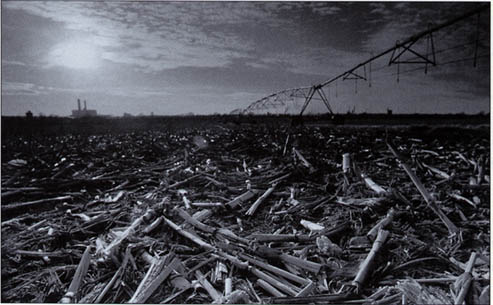 Illinois is nearly 80 percent farmland, and millions of pounds of synthetic pesticides are used on it each year.
who would turn the world over to the insects. They whispered that her book was a woman's sad attempt to expiate the anger over her own cancer. Fortunately, more perceptive heads to some degree prevailed - a presidential commission sustained the charges wrought in Silent Spring. The "Age of Ecology" was born, and Congress even passed a few environmental protection laws. It was not enough. As Steingraber relentlessly documents, the laws passed in response to threats exposed by Rachel Carson are altogether inadequate and cosmetic. We have outlawed DDT and Chlordane (for use, but not for manufacture), but we have no adequate safeguards to evaluate the newer generations of chemicals. We are far more subtle than in Carson's time, but we still dump chemicals on anything that grows, either to kill it or supposedly protect it from something else that will. We now use twice as much chemical pesticide as we used in 1962, the year Silent Spring was published. Leaving aside for the moment that there may be more efficient and economic ways to improve our crop yields, let us address the fact that we simply do not know what the effects of this stuff are. In the meantime, the incidence of cancer in the United States has tripled since World War II. It is very difficult to blame that much cancer on demography and smoking. Sandra Steingraber illustrates best the mind-set accompanying the proliferation of chemical use since 1945 by noting that these were the byproducts of war. Like radiation -the other major suspect in the search for the environmental causes of cancer - synthetic organic chemicals were originally the products of the ongoing search for new forms of weaponry. These chemicals were explored into existence in the hopes of finding a newer, more efficient from Living DownstreamThere are individuals who claim, as a form of dismissal, that links between cancer and environmental contamination are unproven and unprovable. There are others who believe that placing people in harm's way is wrong – whether the exact mechanisms by which this harm is inflicted can be precisely deciphered or not. At the very least, they argue, we are obliged to investigate, however imperfect our scientific tool: with the right to know comes the duty to inquire. Happily, the latter perspective is gaining esteem as many leading cancer researchers acknowledge the need for an "upstream" focus. As explained at a recent international conference, this image comes from a fable about a village along a river. The residents who live about a village along a river. The residents who live here, according to the parable, began noticing increasing numbers of drowning people caught in the river's swift current and so went to work inventing ever more elaborate technologies to resuscitate them. So preoccupied were these heroic villagers with rescue and treatment that they never thought to look upstream to see who was pushing the victims in. Sandra Steingraber |
Pages:|1 ||2 | |3 ||4 | |5 ||6 | |7 ||8 | |9 ||10 | Pages:|11 ||12 | |13 ||14 | |15 ||16 | |17 ||18 | |19 ||20 |
Pages:|21 ||22 | |23 ||24 | |25 ||26 | |27 ||28 | |29 ||30 | Pages:|31 ||32 | |33 ||34 | |35 ||36 | |37 ||38 | |39 ||40 | Pages:|41 ||42 | |43 ||44 |